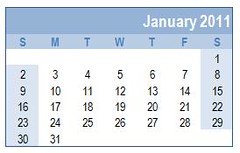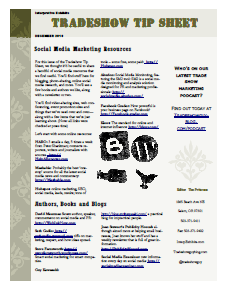Social Media Planning: What to Do In the First Quarter of ’11

Depending on what your company’s involvement is in social media, there are a number of approaches you can take to moving forward during the first quarter of 2011. And that’s the KEY: MOVING FORWARD from wherever you are at this moment. With the forward motion of all things social media, if you sit still you’ll get further and further behind!
If your company is NOT doing anything with social media:
If you’re at the very beginning, you’ll have to start somewhere. Starting anywhere is better than not starting at all. Ask around the office, and look for your company’s own ‘digital native.’ This is the person that’s already online with social media. They’re already on Facebook and Twitter. They may be posting fun videos on YouTube or Facebook. Perhaps they’ve got a LinkedIn account. They’re adept at discussing and moving around in the social media world.
Once you find that person, sit down with your marketing manager and the company owner (presuming you’re a small or medium-sized company and have easy access to these people) and discuss the following steps:
- Where you are
- Where you want to go in the next 3 – 6 months
- What tools you’ll need
- Who will be in charge of the company’s social media efforts
- How much time it will realistically take to set up accounts and start to build your community
- What are your goals
- What are the steps required to meet those goals
- What other internal or external help you’ll need
At this point, you’re really doing a full assessment of where the company is in social media. Find out what your strengths are, where the holes are in your knowledge and determine the best way to fill those gaps. Here is where you’ll also be appointing someone (or two or three) that have the capabilities to lead the company’s social media efforts.
From here, look to what how you can start to create a community, stay in touch with them and provide them with information, content and response to their feedback.
Then, start: get the Facebook and Twitter accounts going, check in daily, put up links on your website to direct people to the new social media outposts. At the outset, once the accounts are set-up (should take a very short amount of time), the initial involvement might be a few minutes a day. As you see more of your community finding you, you’ll have more opportunity to ask questions, look for feedback and find ways to respond to their comments and questions.
If your company IS ALREADY involved in social media…but you feel there’s a LOT more you could be doing:
GET CREATIVE: If you’re past the first few baby steps described above, this is where you can start to get creative with your postings. Take note of what other companies that ‘get’ social media do. Riff off of their efforts. Come up with ways to creatively produce short videos that show the human side of your company, such as this one from gDiapers that was a video birthday present where employees described what they liked about their boss Kim.
VIDEO is a great tool to share how-to’s, information, what-ifs and much more. It’s an invaluable tool to humanize your company. How can you be creative with your videos?

EVENT CALENDAR: Create an event calendar that outlines your company’s 2011 event schedule. Determine which of the events is the most important, and focus on putting together a significant social media effort into connecting with your community around that event. Don’t ignore the other events; but by choosing a ‘most significant’ event, your social media efforts will fall in line. If you choose to, for instance, do a lot of giveaways via Twitter at the big show, plan on supplementing your other shows with smaller Twitter giveaways. If you’re planning a Tweetup at the big show, think about putting together smaller Tweetups at your smaller shows.
LISTEN: Consider digging deeper with your listening tools. The more you listen to what’s being said online about your products, company and competition, the quick you can respond to issues that arise. Tools such as Radian6, Jive Software, Hubspot and more offer access to deep, real-time conversations around the important things in your world. Some are free, some are paid, but all can help lift the lid a little more on what people really think.
RESPOND: When you come across a conversation that relates to your product or service offerings, step in. David Meerman Scott, in his newest book “Real-Time Marketing and PR,” tells the tale of a company that saw a comment from someone who was not happy with the non-response from a company on a request for quote for a telephone system. The company politely stepped in offering to help on any questions or to offer a quote. Long story short: they sold a $250,000 phone system be responding to a tweet and asking if they could help. So yes, this stuff does happen. It is important and it shows that by responding to an issue in real-time, good things can happen.
BLOG: If you’re not blogging yet, this is an opportune time to figure out how your company can use a blog to stand out in the crowded marketplace. Blogging is not a casual commitment; it requires consistent time, energy and thought, and there’s likely no immediate payoff. But a blog is the best online tool to position your company as a leader in your field, share ideas, create community, and stake out ground.
If your company is neck-deep in social media:
If you’re already doing great things with social media, you probably have a good sense of how you got here, and perhaps where to go from here.
CONTINUE LISTENING: look at different tools that can help you uncover conversations that you previously didn’t hear about. Look at new tools. Keep your ear to the ground. Read blogs on social media such as the Social Media Examiner and Mashable.
BUILD YOUR NETWORK: The wider and deeper your personal and professional network, the more opportunities that will arise out of that network. You’ll find new knowledge, timely information and quicker access to new tools.
ENHANCE YOUR PRESENCE: Since you’re already blogging and you’re on Twitter, Facebook, YouTube, LinkedIn and perhaps other social media outpost, ask yourself: how can we enhance the connectivity of these tools? What can we do to show our community who we really are? What can we do to reach more of them? Do we share more of ourselves? Do we offer more how-to’s and tutorials? Do we do more webinars? Do we bring in experts in the field and interview them? Do we step up to a higher level of video production? No matter where you are, there is always room for improvement. How can you improve either in incremental steps or in a big leap?
Social media is many things. It’s a great learning tool. It’s an amazing real-time connectivity tool. It’s hard work; it’s fun. It’s unlike anything the world has seen up until this century and it’s changing the nature of business. It is leading to transparency in more company activities. It empowers consumers to gather information from unlimited sources before they commit a dollar to a purchase.
Social media is perfect for the event world. Events are inherently social. Business is social. By learning how to effectively use the social media tools at your disposal, you’re moving a step ahead of your competition and a step closer to creating a valuable community that will help support your business.







